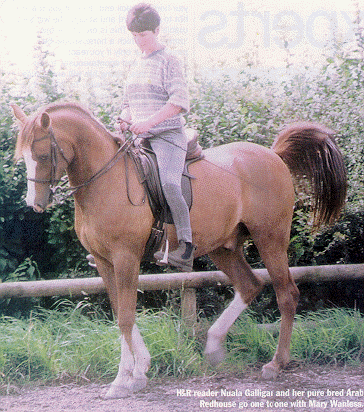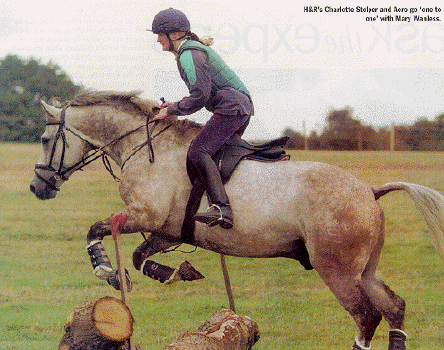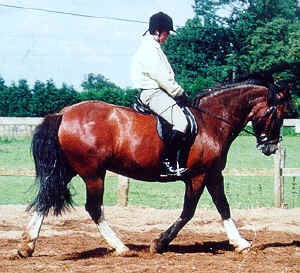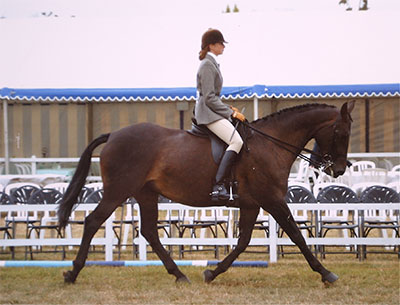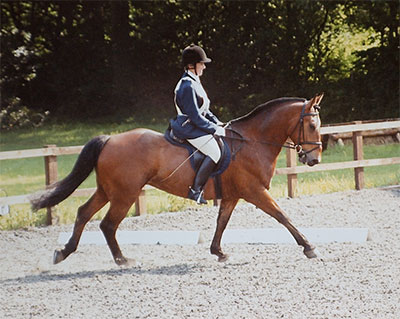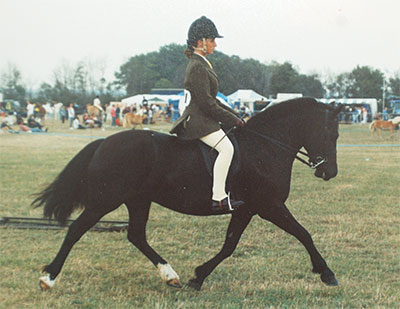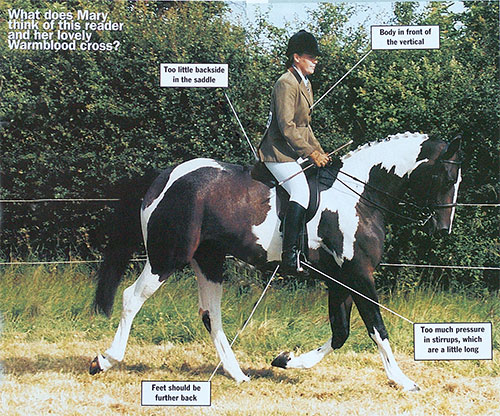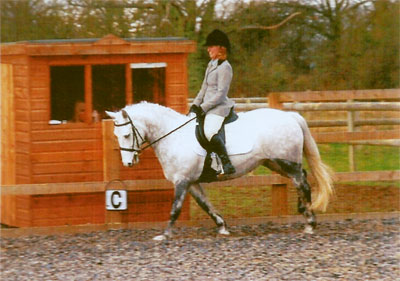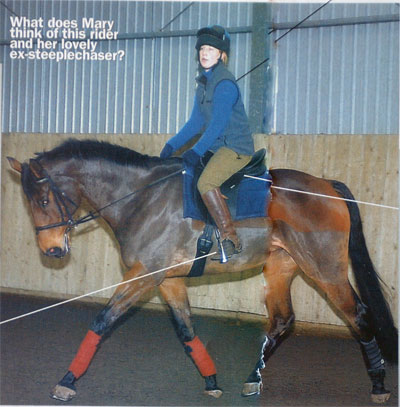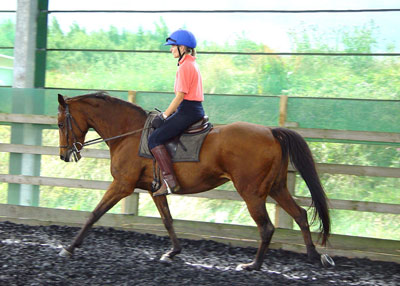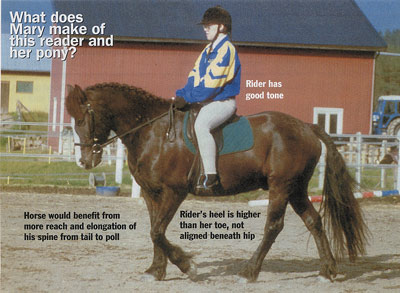RWYM
ARTICLE 15
 The Welsh cob/Hanovarian gelding in the photograph is a ten year old who has been owned by his present rider for six years. She has only been riding for eight years, and is in her mid forties, so I think it’s quite impressive that she took and passed her BHS State 2 examination last year. She says however that she has ‘been to hell and back again with Leo, but we are emerging into the light of partnership again…nevertheless it is “make or break time” for us, and if we do not progress we shall have to part company’…
The Welsh cob/Hanovarian gelding in the photograph is a ten year old who has been owned by his present rider for six years. She has only been riding for eight years, and is in her mid forties, so I think it’s quite impressive that she took and passed her BHS State 2 examination last year. She says however that she has ‘been to hell and back again with Leo, but we are emerging into the light of partnership again…nevertheless it is “make or break time” for us, and if we do not progress we shall have to part company’…
I wish she had told me more about what has actually happened, because I can only surmise this from the photograph. My first impression is that she rides well, and that there is a lot to like about the horse’s trot. The photograph is taken from an unusual angle, which makes it difficult to assess the position of the horse’s head and neck, and this is the most questionable part of the picture.
Close scrutiny of the photograph suggests that the bit is a pelham with roundings, and that the rider is also using a rather tight standing martingale. Perhaps the horse has stood up with her, in which case she has my sympathy – even though I would much rather not see his head held down like this. Even the purists amongst us can acknowledge that there comes a time when the rider’s safety has to come first; yet the real solution to the problem can only come through addressing its cause and not its symptoms.
I hope that the rider has checked her horse out from every possible standpoint, to discover if a veterinarian, farrier, saddler, as well as bodyworkers of various disciplines can find a reason for his trip to hell. The vast majority of horses who act up have a physical reason for not wanting to play the game that we call riding. Think of the many people you know who are in pain, but not actually lame, and then apply that idea to horses. I had been around horses for years before an equine chiropractor planted in my mind the idea that horses could have headaches! They can only tell us about their pains through their behaviour, and it can take exceptionally skilled practitioners to unravel the puzzle. And of course, there is the added problem that all these assessments cost money…
A tiny percentage of horses want to be stroppy, and they have a genetic make-up which make them more difficult to win round. Remember that horses do not spend twenty three hours a day standing in their stables and thinking ‘How can I make her mad tomorrow? How can I make her so angry that she’ll beat me black and blue?’ Fortunately the new genre of equine behavourists have answers for the horses who seem as if they do, and their approach is far more effective and humane than our traditional philosophy of the stick and the carrot. Whatever the cause of his problems, it would probably help this horse enormously to do a join-up.
Let’s come back to the picture. Our rider is sitting quite well, and avoiding some of the common mistakes of poor rider biomechanics. These almost always make a bad situation worse. Her stirrups are quite a sensible length, and she is close to the alignment which would have her land on the arena on her feet if we took her horse out from under her by magic. Her thigh and calf show a good arrowhead-shape, with the knee as the point of the arrow. She is not making the mistake of pulling her ribs up away from her hips, and pushing hard down into the stirrups. This interpretation of the words ‘Grow up tall and stretch your legs down.’ causes riders so many problems that I despair sometimes of the way in which the blind lead the blind down a route towards poor rider biomechanics.
Our rider is perhaps a fraction in front of vertical, but she has a very nice line from elbow, to hand, to horse’s mouth. The horse is tracking up well, and this photograph shows clearly how the hind foot is landing in the hoofprint left by the fore foot. This horse is either an active, forward going type by nature, or our rider knows (from her trip to hell) that she has to ride him forward at all costs. If you become nervous on a difficult horse, it tempts you to ‘back off’ and become too passive, so this may well represent brave riding on her part.
Interestingly, the hind hoof has landed on the ground whilst the diagonal forehoof has not yet landed. This is known by the researches who study gait mechanics as ‘advance diagonal placement’, and it is a sign of a talented horse (from a dressage perspective). This horse’s weight will be carried on his hind quarters much more easily than it will for the horse whose front foot lands before the hind. (This means that trot, which looks to the naked eye as if diagonal pairs of legs land at the same time, can show variations on this theme.)
What concerns me most about this horse is his head and neck, and although we cannot see clearly from this angle, I think he is very overbent. Compare the line of his nose to the line of the vertical fence posts, and notice too that the poll is not the highest point of his neck. It looks as if the martingale would barely give him enough leeway to have his nose vertical – which means that it is extremely tight.
I would like to see this rider ‘cut him some more slack’, and if she does not feel safe enough to do that, perhaps she should get someone to ride him who would feel safe. This is easy for me to say when I have not lived through her experience, and I cannot actually know whether his reaction would be to say ‘what a relief’ or to resume his naughty tricks. If this is the case, it is back to the drawing board, and to a team of experts who can get to the root of the problem.
I do not see anything in this rider’s riding which would make the horse want to act up, and her rider biomechanics are unusually good.However, it is undoubtedly true that tying a horse’s head down can make him feel claustrophobic, and increase his need to escape from the restriction. (We do not see that happening here, but I still cannot endorse the use of such a tight martingale.) I certainly commend this rider for not developing a clutching, defensive style of riding, and would like to see her build further on her strengths.
The next step in her learning will come from becoming stronger in her way of bearing down. She also needs to become more glued to the saddle, and more effectively ‘plugged in’. (I have written extensively about these concepts of rider biomechanics in my books). This will make her look more ‘part of the horse’, and will give her more of the right kind of strength both to make things go right, and to deal effectively with situations in which they go wrong. But strength is only part of the deal: skilful riders have such subtle perceptions that they are able to nip potential problems in the bud. Instead of applying massive corrections after things have already gone wrong, they intervene before an observer has even seen the evasion happen. On a horse who is quick and determined this may feel more like a nice idea than a liveable reality; but keep seeking the tiny clues which warn of impending problems, and keep refusing to take on a ‘battle’ frame of mind.


